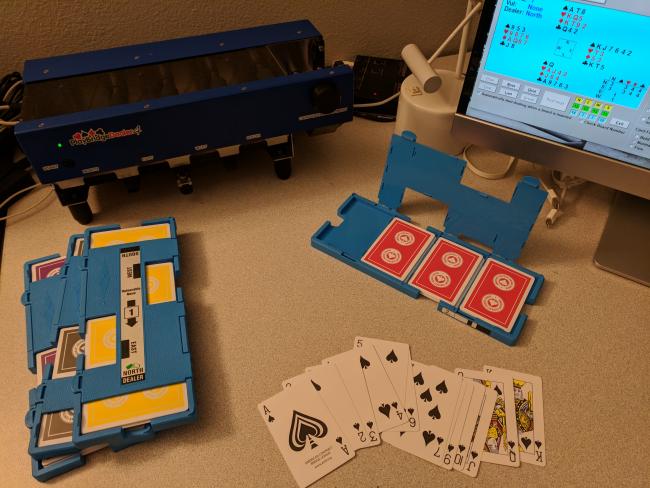
My desk with boards, cards, and the Playbridge Dealer4 machine.
Morris Jones
March 11, 2018
When I was deciding how to equip my bridge club, I took my cues from the ACBL North American Bridge Championships. As the pinnacle of tournament play, and heavy-duty supply usage, I had a strong bias toward their selections.
I purchased "Neo Classic" bidding boxes. (They take more space than the folding boxes, but are more durable.) I bought "Imperial-Plus" duplicate boards to use in a Dealer4 dealing machine, Cosco tables (the MECO tables are good too but have minor problems).
For playing cards, I had a treasured set of plastic cards from a company that's no longer in business. They had a perfect feel, shuffled smoothly, and lasted forever. But if you put a couple of decks in the dealing machine, they would go flying everywhere. The culprit appears to be static electricity -- causing the cards to "float" slightly instead of landing smoothly in the pockets.
Clearly the choice to make was, again, the same as the NABC: the ACBL "plastic coated" paper cards. When they're new (or newish) they feel perfect, shuffle well, and handle confidently. Best of all, when used with a Dealer4 dealing machine, they sort well.
The paper cards also collect oil and dirt, turn a little dingy on the edges, and easily get burrs that catch on other cards. After a dozen or so plays, I feel the need to throw them out and put in new ones. Back in San Jose I used to replace three dozen decks every month.
It was always a treat to start a big tournament with brand new cards, knowing they would be toast by the end of the week.
(Indeed using paper cards with the Dealer4 extends their life by giving them a bit of a cleaning as they pass through the rollers. Undoubtedly this is why the machine itself needs cleaning so frequently.)
Fast forward to November 2017 when the NABC was being held in nearby San Diego.
I sat down at my first event, seeing shiny new cards, in Imperial-Plus boards, with a Neo Classic bidding box at my side, the paper bidding cards neatly sorted into their familiar places. I happily pulled my hand from the board and almost jumped out of my seat, "WTF?"
These were not the familiar plastic-coated paper cards, they were all-plastic, satiny finish, ACBL-logo playing cards. They had a perfect handling weight and thickness.
I had to play a couple of hands before I found an Ace of Spades in my hand so I could see the imprint there, which just said "American Contract Bridge League."
I knew something was up. Between sessions, I visited the Baron Barclay booth and asked "What's going on here?" and got the response, "Oh, you noticed?"
I knew that the main failure point for plastic cards was going to be the dealing machines, and they must have solved that problem. Indeed they had. Terry from Playbridge demonstrated how the new cards would sort perfectly and settle into their pockets. I believe he even said they made some firmware updates to handle the cards better.
(I'm imagining some interesting material science going into the plastic formulation -- inserting some ions into the mix that would dissipate the static charge.)
I immediately started seeing dollar sign$ in my head. I knew I was going to replace all of my cards with these.
A couple of weeks ago, as a test, I ordered three dozen decks of all-plastic ACBL cards. My friend Adam Barron was having problems with plastic cards in his Dealer4, and I wanted to see if the new cards would live up to the promise.
Indeed the new cards behaved beautifully in the machine. They sorted more quietly and settled smoothly into the board pockets. I would get an occasional "leaner" that might cause a jam -- mostly in the far-left North pocket, but those were rare. There were no feed errors or stuck cards.
The reactions from players at the games will always be mixed. Most, I believe, get a little thrill handling the luxurious feeling cards. They do require a different grip and touch. Since they slide across each other more easily, a tight grip can cause one to lose control of the cards. There's a brief adaptation time as players get accustomed to the feel. And of course there are those who just don't like them because they're different and new.
Mostly the cards have a feel of luxury. They are heavier, with a similar thickness to the paper cards, and have a satiny finish that's never shiny or sticky. They should shuffle extremely well (if they ever get shuffled) -- there will never be cards that are likely to stick together or catch on edge burrs.
As a club manager, it's a delight to be able to offer a premium experience to the players and have confidence in the cards handling in the dealing machine. Yes, they're about twice as expensive as the paper cards, but I'm guessing they'll last at least four times longer. I'm looking forward to finding out.
I've ordered several dozen more cards, and am busily repopulating all of my board sets for use in my games and classes.
